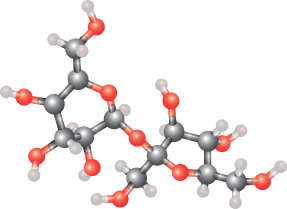– Classification:
– Two functionally different classes of disaccharides exist: reducing and non-reducing disaccharides.
– Reducing disaccharides include lactose, maltose, and cellobiose, which have a free hemiacetal unit.
– Non-reducing disaccharides like sucrose and trehalose bond through an acetal linkage.
– Woehlk test and Fearons test can detect reducing disaccharides.
– Non-reducing sugars offer stability in storage due to reduced chemical reactivity.
– Formation:
– Disaccharides form from two monosaccharides through a dehydration reaction.
– Milk sugar (lactose) forms from glucose and galactose condensation.
– Sucrose results from glucose and fructose condensation.
– Maltose is a condensation product of two glucose molecules.
– Glycosidic bonds are formed in the dehydration reaction.
– Properties:
– The glycosidic bond in disaccharides can be formed between any hydroxy group.
– Different bond combinations and stereochemistry result in diastereoisomers.
– Disaccharides vary in crystallinity, water solubility, sweetness, and stickiness.
– Disaccharides can form glycosides by bonding with other organic compounds.
– Regiochemistry and stereochemistry influence the chemical and physical properties of disaccharides.
– Assimilation:
– Digestion of disaccharides involves breakdown into monosaccharides.
– Maltose, cellobiose, and chitobiose are hydrolysis products of starch, cellulose, and chitin.
– Disaccharides are broken down into monosaccharides for assimilation.
– Carbohydrate digestion plays a crucial role in disaccharide assimilation.
– Enzymes like sucrase, lactase, and maltase aid in disaccharide breakdown.
– References:
– Various sources provide information on disaccharides and their properties.
– Glycosidic bonds, stereochemistry, and regiochemistry are discussed in the literature.
– The classification and formation of disaccharides are detailed in scientific publications.
– Assimilation of disaccharides and their role in metabolism are studied extensively.
– Enzymes and reactions involved in disaccharide digestion are well-documented in academic resources.
A disaccharide (also called a double sugar or biose) is the sugar formed when two monosaccharides are joined by glycosidic linkage. Like monosaccharides, disaccharides are simple sugars soluble in water. Three common examples are sucrose, lactose, and maltose.

Disaccharides are one of the four chemical groupings of carbohydrates (monosaccharides, disaccharides, oligosaccharides, and polysaccharides). The most common types of disaccharides—sucrose, lactose, and maltose—have 12 carbon atoms, with the general formula C12H22O11. The differences in these disaccharides are due to atomic arrangements within the molecule.
The joining of monosaccharides into a double sugar happens by a condensation reaction, which involves the elimination of a water molecule from the functional groups only. Breaking apart a double sugar into its two monosaccharides is accomplished by hydrolysis with the help of a type of enzyme called a disaccharidase. As building the larger sugar ejects a water molecule, breaking it down consumes a water molecule. These reactions are vital in metabolism. Each disaccharide is broken down with the help of a corresponding disaccharidase (sucrase, lactase, and maltase).
